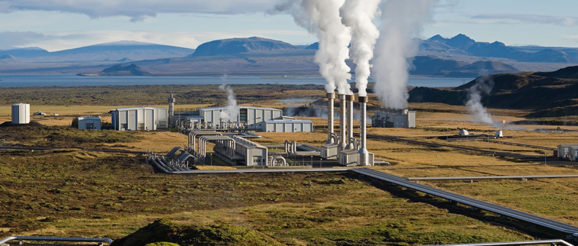Bipartisan Focus on Energy Innovation Emerges


A congressional subcommittee has advanced three energy-related bills that push for technological innovation in geothermal energy development, battery storage, and power grid modernization—innovations that could help to slow greenhouse gas emissions.
Geothermal energy legislation “takes important steps toward advancing a woefully underutilized source of energy.”One of the bills, the Advanced Geothermal Research and Development Act of 2019 (H.R. 5374), “takes important steps toward advancing a woefully underutilized source of energy,” said Rep. Sean Casten (D-Ill.) at the 19 December markup of the legislation by the Subcommittee on Energy of the House Committee on Science, Space, and Technology.
The legislation, which was introduced by the full committee’s ranking member Rep. Frank Lucas (R-Okla.), was approved with bipartisan and unanimous support, as were the other two bills. The bills now go to the full committee for consideration.
Geothermal energy, which is literally heat derived from Earth, contributes to just 0.4% of electric power generation in the United States, according to the Energy Information Administration of the U.S. Department of Energy (DOE). Although the United States already generates more total power from geothermal sources than any other country, proportionately, it pales in comparison with geothermal leaders like Iceland, which gets 26% of its total electric power generation from geothermal, according to a report by the Atlantic Council, a Washington, D.C.–based think tank.
A 30 May DOE report, GeoVision: Harnessing the Heat Beneath Our Feet, noted that there is enormous untapped potential for geothermal electricity generation in the United States from “vast and geographically dispersed” resources. These resources aren’t just located near volcanically and hydrothermally active areas like Yellowstone National Park; rather, the report stated, “Shallow-earth resources exist across all 50 states and can be used for [geothermal heat pumps] wherever the ground can be cost-effectively accessed to depths below seasonal temperature variations.”
“If harnessed correctly, [geothermal] resources can provide secure, baseload power and energy storage for Americans across the country.”The report found that by 2050, geothermal power generation could increase more than 26-fold from today and reach 60 gigawatts of installed capacity, providing 8.5% of all U.S. electricity generation. However, “challenges in resource exploration, drilling, and development present fundamental barriers to improved economic capture of geothermal resource potential.”
The new legislation aims to overcome barriers to realizing geothermal resource potential, according to Lucas, providing DOE with funding for innovative research in advanced geothermal technologies. The legislation specifically calls for DOE to support the establishment of up to three field research sites called Frontier Observatory for Research in Geothermal Energy sites “to develop, test, and enhance techniques and tools for enhanced geothermal energy.” The bill also would authorize a new program in advanced geothermal computing and data science research and development, among other measures.
Geothermal heat “is a source of clean and renewable energy that is always on,” Lucas said at the markup. “If harnessed correctly, [geothermal] resources can provide secure baseload power and energy storage for Americans across the country,” he said.
Committee member Rep. Dan Lipinski (D-Ill.) said the legislation would also bring environmental benefits. “Efforts like this to promote alternative energy sources will contribute to a cleaner future with lower greenhouse gas emissions,” he said.
Advancing Energy Storage Technologies
Rep. Bill Foster (D-Ill.), another member of the committee, said that legislation he introduced, the Better Energy Storage Technology (BEST) Act (H.R. 2986), also would provide climate benefits.
“Energy storage is essential for making progress toward a clean energy economy.”“Energy storage is essential for making progress toward a clean energy economy,” Foster said at the markup.
The bill would establish a research and development program for energy storage systems, components, and materials across multiple DOE program offices, and it requires that DOE “analyze the need for various types of energy storage to improve electric grid resilience and reliability.” A third bill approved by the committee in its markup, the Grid Modernization Research and Development Act of 2019, also focuses on improving the grid.
Energy storage is vital for the advancement of renewable energy and the security of the electrical grid, according to the Environmental and Energy Study Institute (EESI). Energy storage “can help address the intermittency of solar and wind power; it can also, in many cases, respond rapidly to large fluctuations in demand, making the grid more responsive and reducing the need to build backup power plants,” a February 2019 EESI fact sheet noted.
The legislation calls for focusing research and development to produce cost-effective energy storage systems that meet benchmarks including producing highly flexible power output for at least 6 hours, having a 20-year operational lifetime, storing energy for several months, and addressing seasonal-scale variations in supply and demand.
“There is a growing recognition that grid-scale energy storage technologies will be an essential part of tomorrow’s grid,” said Rep. Casten. The BEST bill also calls for developing a 5-year strategic plan to identify research, development, demonstration, and commercial application goals for the program.
Kelly Speakes-Backman, CEO of the Energy Storage Association, an industry group whose members include leading energy storage development companies, said in a statement that the BEST bill “would accelerate innovation and ensure that grid planning and operations fully utilize the flexibility of energy storage.”
Rep. Casten said, “One of the largest barriers we have to the deployment of clean energy resources is whether we have a grid that has the requisite transmission reliability and flexibility to handle the increases in intermittent and non-traditional sources” such as wind and solar energy.
He added that energy storage can help to increase the reliability and resilience of the electric system during and after extreme events. “If we want to both lower greenhouse gas emissions and maintain a stable grid, or in fact if we only want one of those things,” Casten said, “we must invest in greater energy storage capacity.”
—Randy Showstack (@RandyShowstack), Staff Writer
